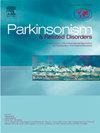帕金森病患者GBA1基因的遗传分析
IF 3.4
3区 医学
Q2 CLINICAL NEUROLOGY
引用次数: 0
摘要
编码溶酶体糖脑苷酶(GCase)的GBA1基因变异是帕金森病(PD)最强的遗传危险因素之一。虽然一些致病突变已被很好地描述,但许多罕见或新颖变异的影响仍不清楚。本研究旨在探索意大利南部PD患者的GBA1变异谱,通过综合遗传和计算机分析,特别关注一种新型错义变异的临床和结构特征。方法采用定制的AmpliSeq覆盖30个PD相关基因,对171例PD患者进行了靶向下一代测序(NGS)。使用UCSF ChimeraX (v.1.10)对鉴定的错义变异体进行结构建模,以评估潜在的构象变化,同时使用DSSP (Define secondary Structure of Proteins)算法分析二级结构。使用FoldX (v.4)评估氨基酸取代对蛋白质稳定性的能量影响。结果10例患者可能携带致病性GBA1变异,包括p.L483P、p.N409S、p.E365K、p.H294Q和p.I200N等常见突变。一种新的杂合变异,p.K505N,在一个家族性PD病例中被发现,并发现在两个受影响的亲属中与疾病共分离。结论本研究扩大了与帕金森病相关的GBA1变异谱,并为新的p.K505N变异的潜在致病性提供了结构证据。本文章由计算机程序翻译,如有差异,请以英文原文为准。
Genetic analysis of GBA1 gene in a cohort of patients with Parkinson's disease
Background
Variants in the GBA1 gene, which encodes the lysosomal enzyme glucocerebrosidase (GCase), are among the strongest genetic risk factors for Parkinson's disease (PD). While several pathogenic mutations are well-characterized, the impact of many rare or novel variants remains unclear.
Objective
This study is aimed to explore the spectrum of GBA1 variants in a cohort of PD patients from Southern Italy, with a particular focus on the clinical and structural characterization of a novel missense variant through integrated genetic and in silico analyses.
Methods
We performed targeted next-generation sequencing (NGS) on 171 PD patients using a custom AmpliSeq panel covering 30 PD-related genes. Structural modelling of identified missense variants was conducted using UCSF ChimeraX (v.1.10) to assess potential conformational changes, while secondary structures were analyzed using the DSSP (Define Secondary Structure of Proteins) algorithm. Energetic impact of the amino acid substitutions on protein stability was evaluated using FoldX (v.4).
Results
Ten patients carried likely pathogenic GBA1 variants, including common mutations such as p.L483P, p.N409S, p.E365K, p.H294Q, and p.I200N. A novel heterozygous variant, p.K505N, was identified in a familial PD case and found to co-segregate with the disease in two affected relatives.
Conclusion
This study expands the spectrum of GBA1 variants associated with PD and provides structural evidence supporting the potential pathogenicity of the novel p.K505N variant.
求助全文
通过发布文献求助,成功后即可免费获取论文全文。
去求助
来源期刊

Parkinsonism & related disorders
医学-临床神经学
CiteScore
6.20
自引率
4.90%
发文量
292
审稿时长
39 days
期刊介绍:
Parkinsonism & Related Disorders publishes the results of basic and clinical research contributing to the understanding, diagnosis and treatment of all neurodegenerative syndromes in which Parkinsonism, Essential Tremor or related movement disorders may be a feature. Regular features will include: Review Articles, Point of View articles, Full-length Articles, Short Communications, Case Reports and Letter to the Editor.
 求助内容:
求助内容: 应助结果提醒方式:
应助结果提醒方式:


